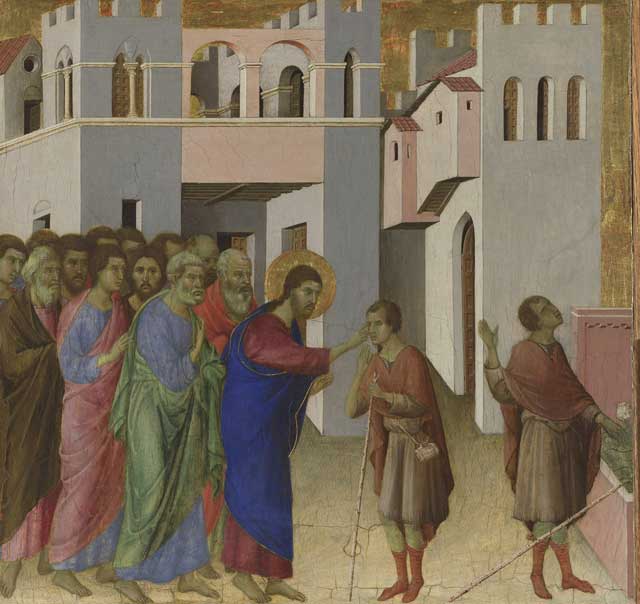Great Works: Jesus Opens the Eyes of a Man born Blind (1311), Duccio di Buoninsegna
National Gallery, London

Your support helps us to tell the story
From reproductive rights to climate change to Big Tech, The Independent is on the ground when the story is developing. Whether it's investigating the financials of Elon Musk's pro-Trump PAC or producing our latest documentary, 'The A Word', which shines a light on the American women fighting for reproductive rights, we know how important it is to parse out the facts from the messaging.
At such a critical moment in US history, we need reporters on the ground. Your donation allows us to keep sending journalists to speak to both sides of the story.
The Independent is trusted by Americans across the entire political spectrum. And unlike many other quality news outlets, we choose not to lock Americans out of our reporting and analysis with paywalls. We believe quality journalism should be available to everyone, paid for by those who can afford it.
Your support makes all the difference.You must change your life": the words come from the poet Rainer Maria Rilke, and his annunciation is a motto of the modern age. Our eyes are commanded to open. And art itself is the gospel. But it is not only new visions that can hold a turn. There are also very old images, which can show a change from one life to another, and in the more literal way.
Of course, at one level, these pictorial stories are clearly odd. They are loaded with bizarre tall tales. They illustrate impossible things. For, clearly, a unified scene can't really contain two separate events. And how can a pair of identical persons, but at different ages, appear in at the same space? But in fact this strangeness is no longer treated as strange. The classical approach may have once strictly insisted on the one-off time in a single place – that was the rule and the sense. Not any more. So many other variations, old and new, have opened up possibilities. And what previously looked rough and naive has become something normal, just one more way of being viewed.
Yet we would do better to notice the surprise of such pictures. The cut-jump between one moment and another moment, the oddnesses, is what we should hold onto. Here is an opportunity for a drama that can arise. Or rather, there can be scenes in which the singular episode creates a sudden climax or crisis. That is one form of drama. But there is also the drama of a radical change, where the revelation is brought out by a two-stage adventure: for example, a miracle.
Duccio di Buoninsegna's Jesus Opens the Eyes of a Man Born Blind is a single panel originally part of the artist's grand altarpiece, known as the Maesta, in the cathedral in Siena. It comes from its back, packed with episodes from Jesus's life, and would have been from along the bottom row. But it works by itself.
It shows a scene of a total transformation. It details a two-stage story, set closely within the same frame and the same place. It is one of those images of change, where a character appears twice, and very close to another. The blind man, with his stick, receives his treatment from Christ, in front of his disciples. Then he stands again as a seeing man, immediately throwing away his stick and raising up his hand in praise. The encounter between Jesus and the blind man occurs at the perfect division of the scene, halfway. Jesus's touch and instruction are strict and stern. The blind man is calm, obedient, holding still, as if receiving an operation. All 12 disciples gather densely behind Jesus, some barely visible, but serious, passionate, concentrated in their attention.
But the drama is not only the junction between Jesus and the blind man. The drama is also the disjunction between the blind man and the seeing man. First there is the meeting: then there is the gap. And this is the great result of the miracle, shown in the two same figures. They both occupy the right side of the scene, and they show their plain contrast – in their different physical positions, in their different states of self.
On the left hand, the blind man is connected to Jesus and his disciples and the divine collective power by which this man is being cured. He is still supported on his upright stick. On the right hand, the seeing man is now a single and liberated man. No longer part of this stationary stance, he is dropping his stick, and moving ahead in the continuation of his life.
The seeing man looks up. He is looking beyond out of the frame. And his two figures show his positions in a further and crucial way. He is turned one way, and then the other way, left and right. In other words, he turns his back upon his own past self. This double figure is the crucial device used by Duccio. He dramatises this man with his definite past and future.
Meanwhile, all above and around, he has his first sight of the world. There is this city, Jerusalem, beautiful, clear, sharp, luminous, each building in its archways and castellations bearing witness to the sense of the eye. This is the image of change, from one stage to another. A new vision. A new life.
ABOUT THE ARTIST
Duccio di Buoninsegna (working 1278-1319), rival in Siena to Giotto in Florence, is founding father to the European pictorial tradition. Not much is known about him. His main work is the Maesta altarpiece, with a Madonna and Child, saints and sngels, and episodes all over the back. He influenced two centuries of Sienese art – rich in narrative subtlety, delicate human interaction and intimate feeling of place.
Join our commenting forum
Join thought-provoking conversations, follow other Independent readers and see their replies
Comments